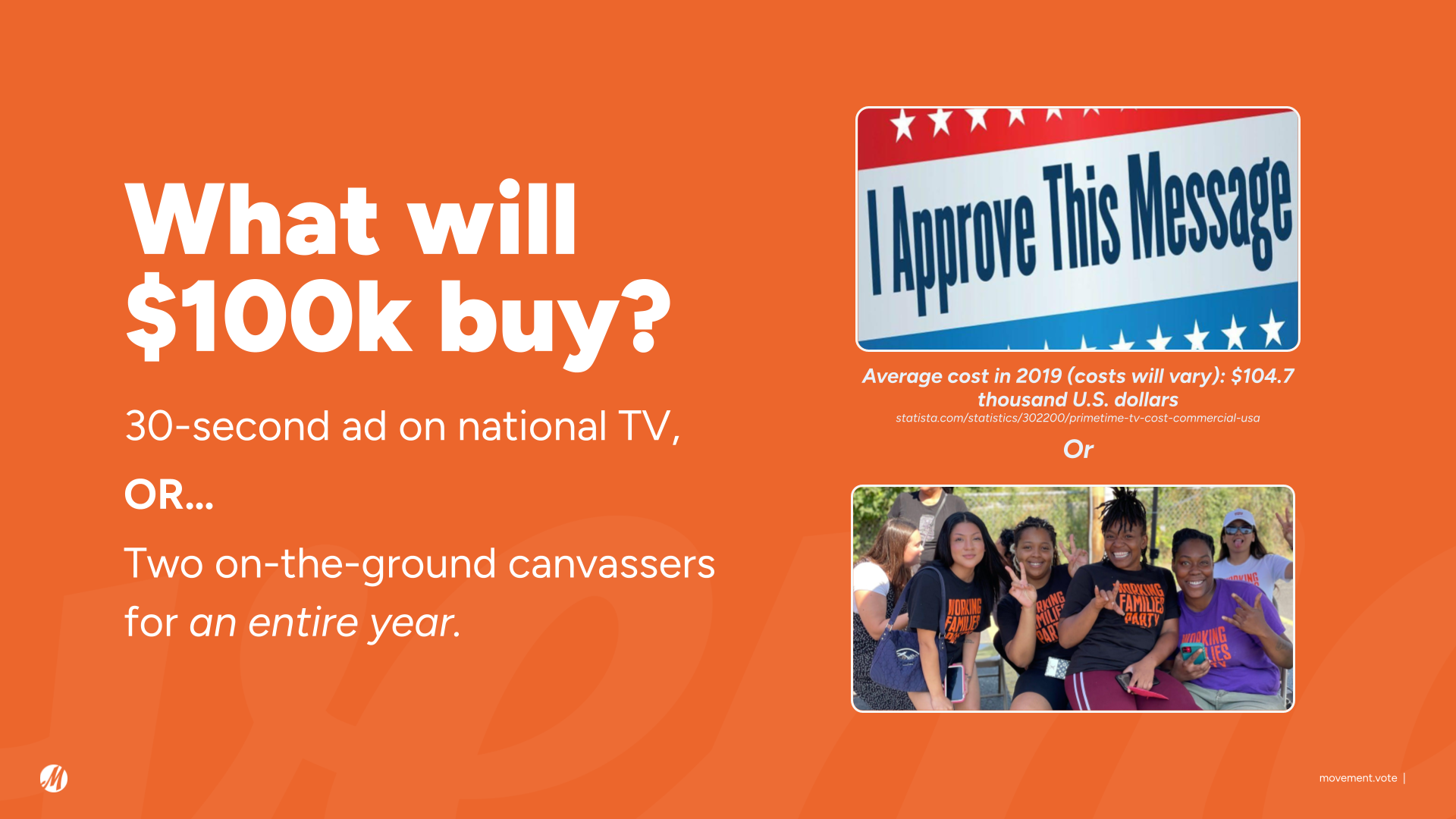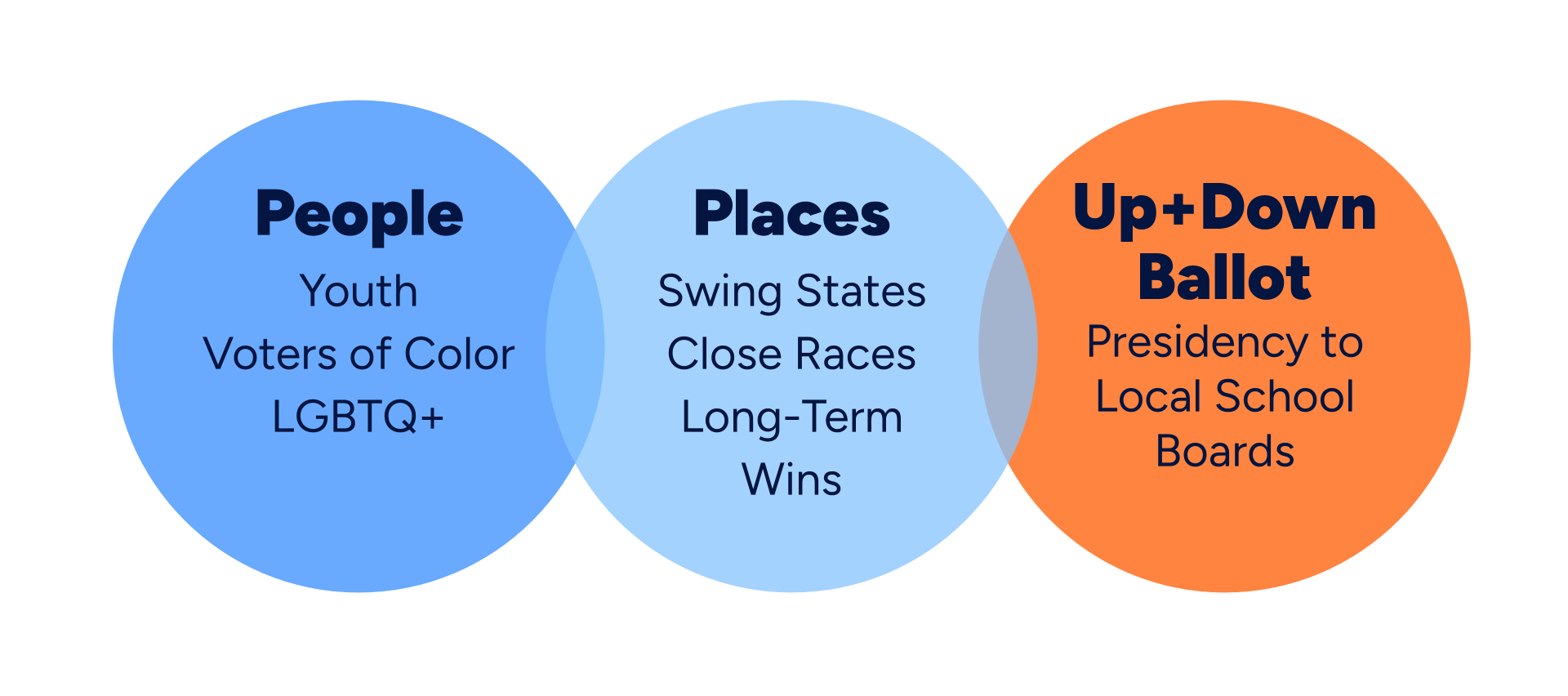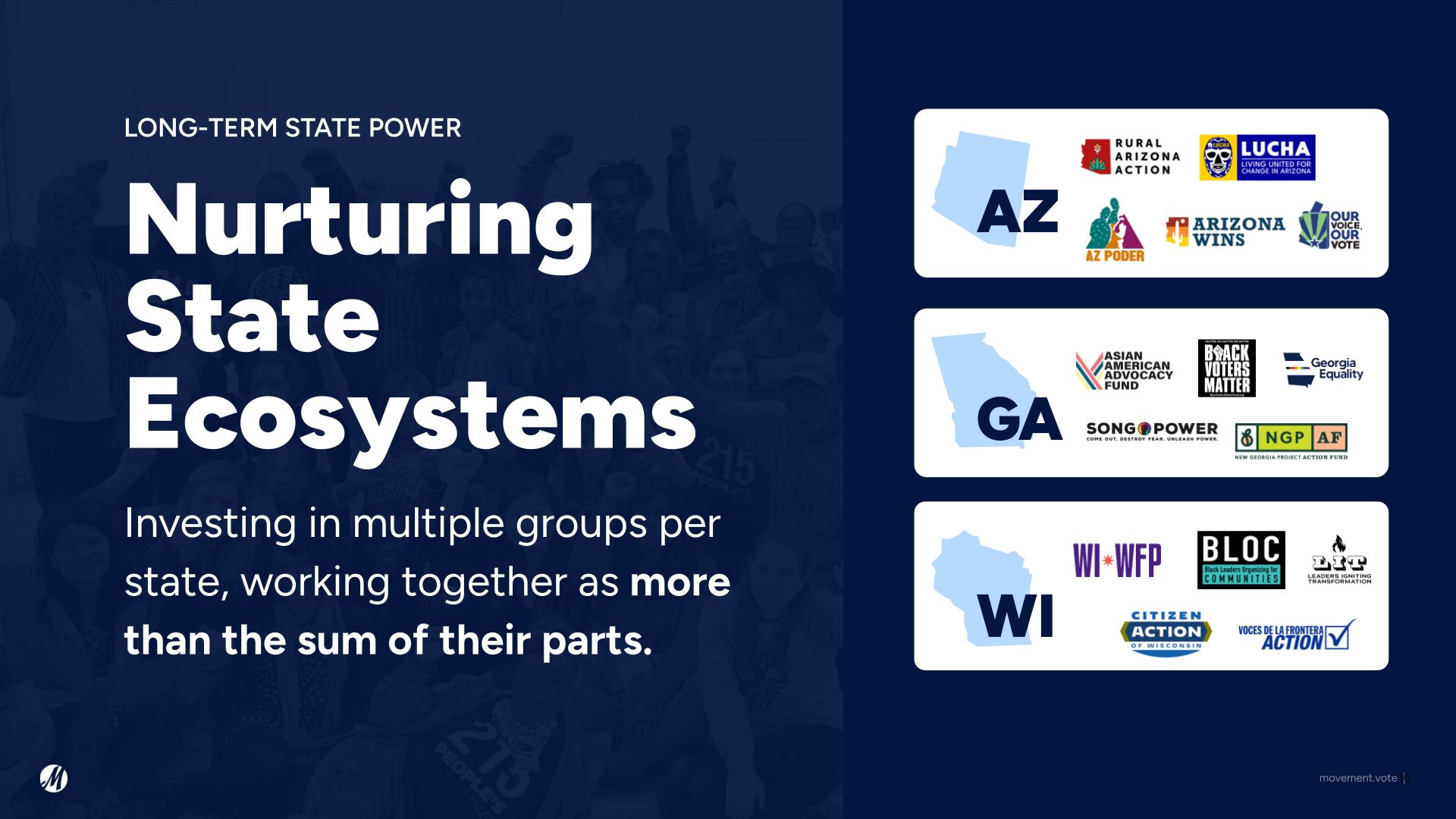Evidence & Research
There is a growing body of empirical evidence and research validating our organizing-based approach. We’ve compiled the best of that research here.
Jump below to:
- Local Voter Organizing
- Long-Term Power-Building Metrics
- Limited Impact of Political Ads
- Broad Political Targeting
- Down-Ballot Focus, Up-Ballot Turnout
- “State Ecosystem” Approach
Electoral Impact of Local Voter Organizing
Investing Small to Win Big: Evidence of Electoral Impact by Local Voter Engagement Groups (May 2024)
By Movement Voter PAC
This piece presents a compelling, data-driven case for the effectiveness of MVP partners’ person-to-person voter engagement tactics in driving voter persuasion and turnout.
Drawing from extensive research, including meta-analyses and experiments, the piece shows the effectiveness of door-to-door canvassing, deep canvassing, and other relational outreach methods, especially among voters in marginalized communities.
“[Investing in locally-based voter engagement] is a brilliant strategy. You are reaching people who traditional campaigns have struggled to reach, and whose language they don’t speak – sometimes quite literally.”
— Steve Grossman, former Chair of the Democratic National Committee
Importance of Long-Term Power-Building Metrics
Power Metrics: Measuring What Matters to Build a Multiracial Democracy (2023)
By Democracy & Power Innovation (DPI) Fund and Harvard Kennedy School
Narrow, funder-driven metrics like “Cost Per Vote” (CPV) incentivize: 1) short-term voter turnout outcomes over long-term power building; 2) transactional voter-mobilization tactics over deeper organizing strategies; and 3) programs that contact higher-propensity voters but neglect the harder-to-reach voters we ultimately want to engage.
Power Metrics is a groundbreaking report — the research for which was done in partnership with many MVP local grantee partners — that seeks to measure and visualize the work of year-round grassroots power building, and to lay out a framework for advancing these “power metrics” across the organizing sector.
From the abstract:
When we seek out the drivers of progressive change in almost any state, we find a handful of entities that organize bases of people who deliver that power over and over again in legislative and electoral campaigns to win change across issues. The problem is that the work it takes to build and continue growing such an organization’s power over time has been largely invisible.
In the spring of 2020, we launched a DPI Organizing Lab with 12 base-building organizing groups to identify the core practices of their power-building work that could be measured and visualized, and that were common across regions and constituencies. These groups explicitly seek to build a base of constituents who can wield long-term independent political power that creates local, state, and national impact.
For the last three years, we have been invested in building a culture of measurement that actually tracks advancement on what matters most in our sector…. in a word: POWER. This memo covers our progress and key findings in this work so far.
Limited Impact of Political Ads
While candidate-based giving often funds ad spending (typically 45% of a Congressional campaign budget), MVP invests in locally-rooted organizing that can mobilize voters that ads cannot easily reach.
For contrast: $100,000 will roughly pay for a thirty-second national TV ad, or two on-the-ground canvassers for an entire year.

Priorities USA (April 2021)
Memo: How Democrats Can Optimize Media Spending And Stop Wasting Millions, by Priorities USA
Context: After the 2020 election, Priorities USA analyzed the $5.4 billion in Democratic and Republican ad spending by candidate campaigns and outside groups.
Findings:
- Democrats likely spent 10% of their ad budgets on voters who’d already voted.
- “Roughly $334 million was wasted on people who had cast their ballot.”
- 75% of TV ads for U.S. House races were shown to voters in other districts.
- “Meanwhile, too little is spent on mobilizing voters, especially down ballot.”
“If we took just 1% of the late spending and invested it in additional organizing infrastructure on the ground, we could generate an immensely higher longer-term return on investment.”
Cambridge University (November 2021)
The Effect of Television Advertising in United States Elections, by John Sides, Lynn Vavreck, and Christopher Warshaw
Context: This comprehensive Cambridge University study examined 4,500 federal and state-level races from 2000-2018 to assess the influence of TV ads on election results. The study provides “the most comprehensive analysis of advertising effects to date.”
Findings:
- TV ads do have an impact, but much less in presidential vs. down-ballot races — and mostly for persuasion (changing undecided voters’ attitudes on candidates), not mobilization (getting partisan voters to vote).
- TV ads only likely sway outcomes “in close races where one party is able to muster a substantial advertising advantage. But we do not claim that this is a common occurrence.”
- The trend of increased partisan polarization and decreased split-ticket voting could “lead to a decrease in the effect of television advertising on elections.”
Broad Political Targeting

We believe targeting “Toss-Up” states and races is essential but not enough. If we want to ensure electoral wins now while growing long-lasting governing power, we need to invest in a wider electoral map.
Square One (September 2023)
“Power Brokers: An Analysis of Outside Democratic Spending in Close Congressional Races”, by Square One
Context: Square One assessed 2021-2022 U.S. House race spending, in an effort to assess and ultimately improve the impact of spending on electoral outcomes.
Findings:
- U.S. House race competitiveness is extremely unpredictable.
- In 2022, the races with the most outside investment were not the closest.
“While there’s no perfect formula for allocating outside dollars, this report does suggest … campaign strategies often deemed “too risky” can actually be a winning strategy. This includes investing in more women, people of color, and members of the LGBTQ+ community, districts across the country long perceived as “unwinnable,” and campaign tactics like field and other forms of direct voter engagement.”
Down-Ballot Focus, Up-Ballot Turnout
MVP invests in local organizations that focus not only on federal races but also on the state, county, and local elections that have a direct impact on voters’ daily lives.
MVP partners get out the vote for these races, as well as identify, recruit, and develop candidates to run in them.
When we invest in local races, we create a “multiplier effect.”

Credit: Run for Something
For Our Future + Run for Something (November 2021)
Reverse Coattails Effect 2016-2020, by BlueLabs Analytics
Context: Run for Something and For Our Future commissioned BlueLabs to study whether Democrats contesting state legislative races could increase vote-share at the top of the ticket in battleground states.
Findings:
- “Folks running for state and local offices were responsible for increasing turnout for statewide or national candidates.”
- “Across states and cycles, we found an estimated 0.4% – 2.3% bump in top-of-ticket vote share when every local state legislature seat within a precinct is challenged.”
- “While Democratic candidates running in districts that would be otherwise uncontested Republican races may not win those seats, they may provide an important vote share bump in close statewide contests”.
“The dollars spent locally go further because they directly reach and educate voters through community based organizing in ways ad-buys and big campaigns can’t. They also build political infrastructure and talent, allowing for us to take a deep red district and over many years, turn it competitive. No race goes from 70/30 to 50/50 overnight!”
“State Ecosystem” Approach
Rather than only funding a few big-name organizations working in silos, MVP invests in a diversified “ecosystem” of groups within a state, working together to build lasting power.

This approach has shown results in several states, most notably Minnesota:
Win the Midwest (2024)
Organizing Was the Heartbeat: The Ten-Year Path to Progressive Governance in Minnesota, by Laura Flynn et al
Excerpt: In 2023, in a little over 100 days, Minnesota’s legislature passed a transformative progressive agenda on a scale not seen since national New Deal legislation of the 1930s. How did this happen? The short answer is: people organized for it. Over a ten-year period leading up to 2023, grassroots organizations allied with labor built enough people power to not just pass a set of policies, but to fundamentally shape and transform the Democratic party in Minnesota. In doing so, they breathed new life into the state’s democracy at a time when our national democracy is under threat. How did an ecosystem of organized people in Minnesota achieve enough scale, depth, cross-racial solidarity, alignment, maturity, and resilience to break through? This case study, based on conversations with a dozen Minnesota grassroots leaders, funders, and electeds, attempts to answer that question.
Georgetown University (2024)
Aligning for Power: A Case Study of Bargaining for the Common Good in Minnesota, by James C. Benton, Patrick Dixon, and Joseph A. McCartin at the Kalmanovitz Initiative for Labor and the Working Poor
Context: In 2022, Democrats won a state trifecta for the first time in a decade, and became empowered to enact an almost-dizzyingly vast progressive agenda. But these breakthroughs did not just happen overnight — they were the result of a coordinated, decade-long organizing strategy by progressive grassroots groups.
In “Aligning for Power,” the authors at the Kalmanovitz Initiative lay out this came to pass thanks to over a decade of coordinated work by labor and community organizations, including MVP partners TakeAction Minnesota and Unidos Minnesota.
Key Excerpts:
- “A foundational insight… was that they were not constructing a transitory coalition, they were building an enduring alignment.” (p.12)
- “The issues that the Minnesota alignment had been campaigning on for years helped to shape political debate in 2022. Having helped the DFL win the “trifecta,” the social and political ecosystem that had emerged … then helped shape a governing agenda that came to dramatic fruition in 2023.” (p.27)
- “The political and legislative breakthroughs won there were not the product of a campaign that set out from the beginning to wage political and legislative fights. Rather, the Minnesota victories began in struggles that brought together workers, renters, immigrants, and others in campaigns that challenged corporate power and built power through direct action and the alignment of multiple organizations and constituencies around a common analysis.” (p.29)
What happened in 2023 was less a miracle than the sweet fruits of a long, innovative campaign built around a brilliant and flexible operational model that aligned multiple membership organizations around a common analysis, deep organizing, and community mobilization.